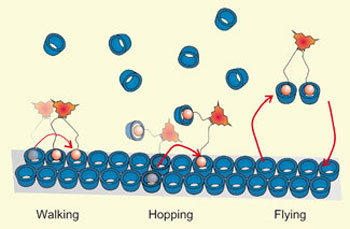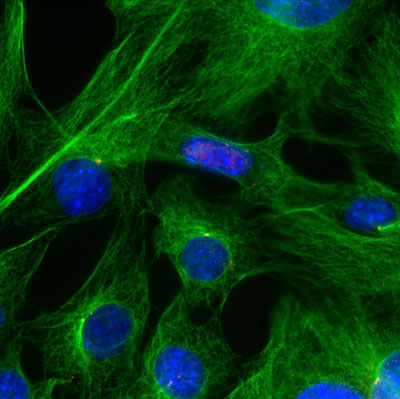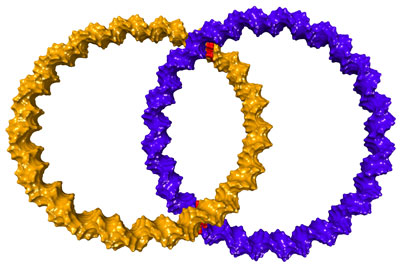Using a special reactor inside a clean room, researchers apply nanometer thick films of aluminum oxide to a sample silver wafer about the size of a silver dollar. The films conform to the recesses and protrusions of the silver, creating a protective barrier.
Apr 11th, 2011
Read more
Science and technology meet art: Nano images, taken directly from the labs of German research institutions, will be on view at the German Center for Research and Innovation (GCRI) from April 13 until June 10.
Apr 11th, 2011
Read more
The NanoCode Synthesis Report on its Stakeholder CoC Survey (pdf) provides the findings of the international, quantitative and qualitative NanoCode survey about the European Code of Conduct for Responsible Nanosciences and Nanotechnologies Research (EU-CoC). The results summarised in this report give insights into stakeholder's patterns of awareness, their expectations, attitudes and appraisals. The survey analyses the degree of compliance and commitment, identifies recommendations for the communication, possible incentives, disincentives and monitoring of the EU-CoC.
Apr 11th, 2011
Read more
Nicknamed "SACLA" (SPring-8 Angstrom Compact Free Electron Laser), the new XFEL's intense beams will open a unique window onto the minuscule structure of molecules and rapid reaction of chemical species.
Apr 11th, 2011
Read more
Tyndall National Institute has began the coordination of a 3m euros EU project for the development of novel smart sensing materials for applications in water purification technology and clinical diagnostics.
Apr 8th, 2011
Read more
 Controlling how molecules move on surfaces could be the key to more potent drugs that block the attachment of viruses to cells, and will also speed development of new materials for electronics and energy applications.
Controlling how molecules move on surfaces could be the key to more potent drugs that block the attachment of viruses to cells, and will also speed development of new materials for electronics and energy applications.
Apr 8th, 2011
Read more
Exactly 100 years ago today, physicist Kamerlingh Onnes cooled mercury to 4.2 degrees Kelvin, or -450 Fahrenheit, and discovered that it conducted an electric current perfectly - no electricity was lost as heat or friction. This phenomenon is called superconductivity.
Apr 8th, 2011
Read more
To train new scientists and engineers to combat the spread of cancer, Johns Hopkins Institute for NanoBioTechnology (INBT) has established a pre-doctoral (PhD) training program in Nanotechnology for Cancer Medicine. Together with the institute's previously established Nanotechnology for Cancer Medicine postdoctoral fellowship, these two training programs will comprise the Johns Hopkins Cancer Nanotechnology Training Center (CNTC).
Apr 8th, 2011
Read more
 Nanotechnology for Cancer Medicine forms the focus of the fifth annual symposium of Johns Hopkins Institute for NanoBioTechnology (INBT), May 12-13, 2011 at the university's Homewood campus.
Nanotechnology for Cancer Medicine forms the focus of the fifth annual symposium of Johns Hopkins Institute for NanoBioTechnology (INBT), May 12-13, 2011 at the university's Homewood campus.
Apr 8th, 2011
Read more
To address occupational risks of nanomaterials, WHO is developing Guidelines to "Protecting Workers from Potential Risks of Manufactured Nanomaterials" (WHO/NANOH). These Guidelines aim to facilitate improvements in occupational health and safety of workers potentially exposed to nanomaterials in a broad range of manufacturing and social environments.
Apr 8th, 2011
Read more
 Wissenschaftlern an der Goethe-Universitaet ist es gelungen, zwei nur 18 Nanometer grosse Ringe aus DNA herzustellen und sie wie zwei Kettenglieder ineinander greifen zu lassen.
Wissenschaftlern an der Goethe-Universitaet ist es gelungen, zwei nur 18 Nanometer grosse Ringe aus DNA herzustellen und sie wie zwei Kettenglieder ineinander greifen zu lassen.
Apr 8th, 2011
Read more
A total of more than 1000 researchers coming from more than 70 major European research institutes in the field of energy are involved in the different EERA Joint Programmes. These scientists are working to accelerate the delivery to industry of a new generation of energy technologies to contribute to achieving the 20-20-20 targets.
Apr 8th, 2011
Read more
A research team at the University of Pennsylvania's schools of Engineering and Applied Science and Arts and Sciences has shown how to control the characteristics of semiconductor nanowires made of a promising material: lead selenide.
Apr 8th, 2011
Read more
DARPA's Systems of Neuromorphic Adaptive Plastic Scalable Electronics (SyNAPSE) program aims to fundamentally alter conventional designs by developing biological-scale neuromorphic electronic systems that mimic important functions of a human brain. Applications for neuromorphic electronics include robotic and manned systems, and sensory and integration applications such as image processing.
Apr 8th, 2011
Read more
Recently, new achievements were made in the integrated optics by the Creative Research Group of Femtosecond Photophysics and Integrated Optics at Peking University. The group realized a novel nanoscale integrated all-optical diode having ultralow power and ultrahigh transmission contrast after the realization of the all-optical switch device with ultralow power and high-speed photonic crystal.
Apr 8th, 2011
Read more
The collaborative initiative involving leading academics and industrialists, led by the University of Strathclyde in Glasgow, is seeking quicker, more effective and more sustainable methods of manufacturing products such as medicines, foodstuffs, dyes, pigments and nanomaterials.
Apr 8th, 2011
Read more




 Subscribe to our Nanotechnology News feed
Subscribe to our Nanotechnology News feed